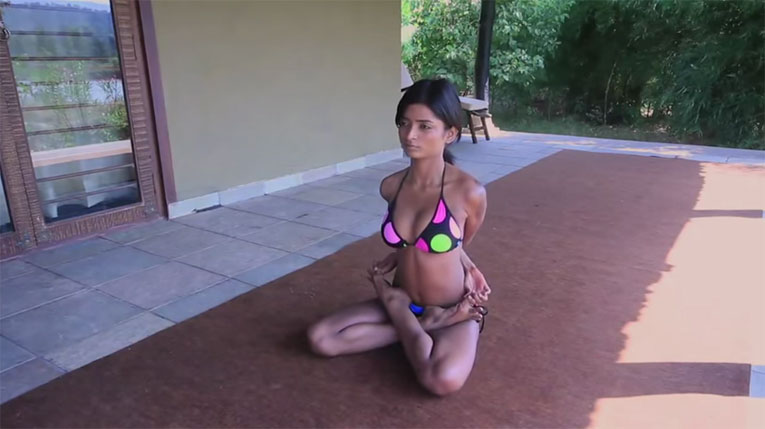The Hatha Pradipikia 1-44 encapsulates the principles behind Baddha Padmasana. It destroys all the ailments affecting your body.
Similarly referring to the Baddha Padmanasana, the Mantrabhaga in Trisikhibrahmanopanishad (39-40) mentions: After sitting in the Padmasana, criss-cross your hands behind your back and hold the toes.

THE NOMENCLATURE
The nomenclature ‘Baddha Padmasana’ means ‘The Locked Lotus Posture’. The term is derived from the Sanskrit words ‘Baddha’ meaning ‘Locked’, ‘Lotus’ refers to ‘Lotus’ and “Asana’ connotes ‘Posture’.
The nomenclature correctly summarizes the posture. The term Baddha is used as during this posture your arms and legs are kept immobilized or locked up. This grants the body a steady position.
The Hatha Pradipikia (1-44) further describes the posture thus: Ensure that your right foot is on the left thigh and also that your left foot is atop the right thigh. Now, cross your arms one by one behind the back and touch the toes. Keep your eyes fixed at the nose tip. Your chin should be placed on your chest.
POINTS TO REMEMBER
* Baddha Padmasana is not for pregnant women.
* Practice Baddha Padmasana only after you master Padmasana.
* Though obese people or the ones having a bulging tummy may find Baddha Padmasana difficult at the initial stages, yet with dedication and constant practice, it would be easy for them too.
* With practice you will be able to do the different yoga mudras while assuming the Baddha Padmasana posture.
* If in the beginning you find it difficult to touch both the toes, you can grasp the uppermost one which is generally easier to catch hold of. However, daily keep on trying to touch both the toes. With time you will be successful.
* Daily practice makes the shoulder joints flexible.
* As you try to hold the toe placed below slightly push your shoulder blades towards each other.
* Your trunk must be leaned forward.
* After successfully catching hold of both toes (right hand holding the right toe and the left hand the left toe), sit erect in that position for 10 seconds or till you feel uncomfortable.
* You can increase the time subsequently
METHODOLOGY
* Remain in the Padmasana.
* Place your feet close to the groin and as high as possible atop the thighs.
* Stretch your right arm behind the waist up to the left hip.
* Slightly lean forward.
* Twist your trunk to the right.
* Tightly hold with your middle finger and forefinger the right toe placed on the left thigh.
* Sit erect in this position for five seconds.
* Then, do the same process with your left arm:
* Stretch your left arm behind the back till it crosses the right forearm.
* Reach out your left hand to reach the right hip.
* Slightly lean forward.
* Twist your trunk to the left.
* Draw in the abdomen.
* Bring the shoulder blades near each other.
* Now hold with your left forefinger and the middle finger the left toe placed on your right thigh.
* Sit erect.
* Your legs and arms will now be firmly interlocked.
* Remain in this posture for 10 seconds.
* Remember that your head, neck and spine must be erect during the posture.
* Both the knees must touch the floor.
* Look straight ahead.
* Breathe normally.
* This is the final position.
After 10 seconds, slowly release the hands. Then unlock the footlock. Stretch out your legs in front. After relaxing for about 15 seconds resume the sitting position.
* Alternate the legs and practise the posture again.
BENEFITS
- Optimize the benefits by doing the Jalandhara Bandha while sitting in Baddha Padmasana
- Your legs become more flexible.
- The benefits you can get from Padmasana can also be got from Baddha Padmasana.
- The joints of toes, ankles, knees, hips, lower back, wrists, elbows, and shoulders also become supple and get stretched to their maximum limits.
- The range of your shoulder movements also increase.
- Pain is alleviated from your shoulders and back.
- The chest is expanded and the ribcage expanded as you cross your arms across your back and pull the toes.
- Your intercostals muscles are also positively affected.
- Any abnormal spinal curvature gets corrected. As a result you improve your posture.
- Abdominal ailments are addressed.
- Your body becomes revitalized.
References:
* Goraksha Samhita: I(11);
* Hatharatnavali: III(4-5);
* Gheranda Samhita: II(8);
* Darsanopanishad: III(11)
